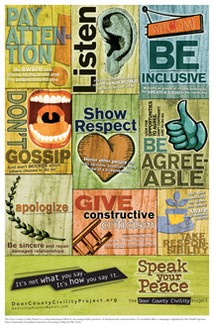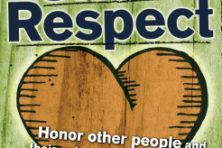Civility Column: Step Away from the Conversation – Part II
- Share
- Tweet
- Pin
- Share

By Susan McAninch
I think I am civil, however, how do I keep engaged with someone who isn’t civil at all? What should I do or say when I am personally attacked by another person? I want to keep talking but it is so difficult!
Refresher from Part I: Being engaged in genuine dialogue requires an environment of psychological safety. When safety is at risk, defenses go up and dialogue ends. Staying engaged in conversation with someone whose defenses are up and who is not being civil requires finding a way to restore safety. Responding respectfully to someone who has personally attacked you requires not responding in kind with your own attack. What does it take to restore safety? What does it take to not respond in kind?
One can readily grasp how easy it is to slip out of a genuine dialogue and into a defensive stance. Just think about the last time you had a casual conversation about where to go for dinner and ended up trying to win an argument. The greater challenge is to find your way back to safety and get back to the original purpose of the conversation.
- Learn to know yourself and monitor your own behavior. No matter how much someone else may need to change, the only person you can control is yourself. And when it comes to contributing to the problems we experience, we are rarely completely innocent. It is important to remind yourself of what you really want from the conversation; what your real motives are. Do you want to solve the problem and make the decision? Or do you feel unsafe and defensive yourself? Will you start looking for ways to win or punish or avoid embarrassment? The better you know yourself, the sooner you will recognize defensive behaviors in yourself and others as signs that safety is at risk. Thus, you learn to think “safety first” instead of responding in kind to defensive and uncivil behavior. Don’t take the bait. It’s not about you.
- Learn to look for signs that safety is at risk. You don’t have to know what the problem is; all you need to know is that something is wrong and you’ve moved away from healthy dialogue. Look for early signs in yourself and others. Signs can be physical, such as facial flushing and dry mouth, or emotional, such as feeling hurt or angry. Behavioral cues, such as a raised voice, finger pointing, or going silent, are signs that safety is at risk. People tend to move in one of two directions: toward silence (examples: avoidance, literally pulling out of the conversation) or violence (examples: controlling by cutting others off; attacking by belittling or threatening).
- Make it safe. Once you recognize that you are no longer in dialogue, step away from the conversation. (“Let’s switch gears for a minute. I think we’ve moved away from the purpose at hand.” Or, “Hey, I think we’re going off track.” Or, “Wow, I feel like I have just been attacked. What’s going on?”) You need to build safety. We make small corrective adjustments all the time. Sometimes safety is restored by an appropriate touch or a smile, or just taking a breather. Show a little more interest in the other person’s views. This is the time for any genuine apologies that are due and the time to clear up misunderstandings. Once safety is restored, step back into the conversation.
Yes, some conversations are very delicate and some people’s defenses are hard-wired. Do not let yourself be discouraged when you find yourself at a loss for words to make things right. Restoring safety is a process, and in countless instances, you will be surprised at how even a little bit of effort will yield big results.
Reference: Crucial Conversations: Tools for Talking When Stakes Are High by Kerry Patterson, Joseph Grenny, Ron McMillan, Al Switzler, and Laura Roppe
Susan McAninch is a retired clinical social worker and psychotherapist.



